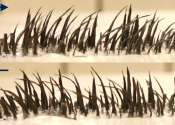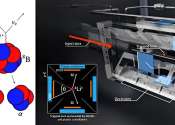In the physical sciences, a particle is a small localized object to which can be ascribed several physical properties such as volume or mass. The word is rather general in meaning, and is refined as needed by various scientific fields.
Whether objects can be considered particles depends on the scale of the context; if an object's own size is small or negligible, or if geometrical properties and structure are irrelevant, then it can be considered a particle. For example, grains of sand on a beach can be considered particles because the size of one grain of sand (c. 1 mm) is negligible compared to the beach, and the features of individual grains of sand are usually irrelevant to the problem at hand. However, grains of sand would not be considered particles if compared to buckyballs (~1 nm).
The concept of particles is particularly useful when modelling nature, as the full treatment of many phenomena is complex. It can be used to make simplifying assumptions concerning the processes involved. Francis Sears and Mark Zemansky, in University Physics, give the example of calculating the landing location and velocity of a baseball thrown in the air. They gradually strip the baseball of most of its properties, by first idealizing it as a rigid smooth sphere, then by neglecting rotation, buoyancy and friction, ultimately reducing the problem to the ballistics of a classical point particle.
Treatment of large numbers of particles is the realm of statistical physics. When studied in the context of an extremely small scale, quantum mechanics starts to kick in, and give rise to several phenomena such as the particle in a box problem and wave–particle duality, or theoretical considerations, such a whether particles can be considered distinct or identical.









